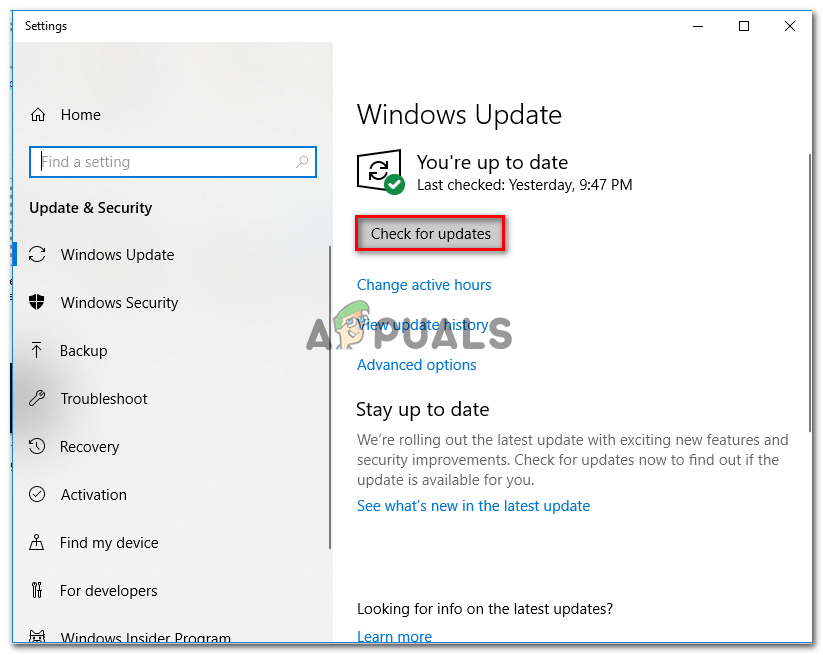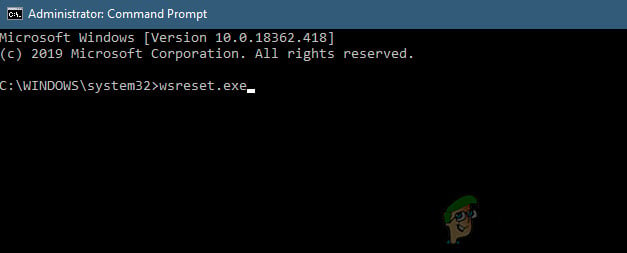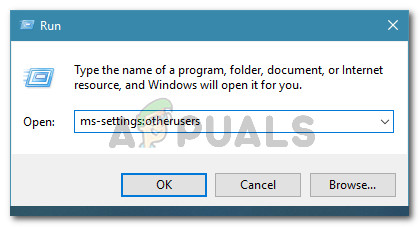Here’s a list of potential culprits that might end up causing this problem:
Method 1: Running the Windows Apps Troubleshooter
Before you try anything else, you should see if your Windows 10 computer is not capable of fixing the issue automatically. Several affected users have reported that they managed to fix the issue by running the Windows Apps Troubleshooter and applying the recommended fix. Keep in mind that this built-in utility contains a selection of repair strategies that can be automatically applied in the event that a familiar scenario is discovered. Here’s a quick step by step guide that will show you how to run the Windows App troubleshooter in order to fix the 0x80073CF6: In case you’re still seeing the same 0x80073CF6 error, move down to the next potential fix below.
Method 2: Installing every Pending Windows Update
According to some affected users, this particular issue is very common on Windows 10 builds that doesn’t yet have the Anniversary Update. It turns out that Microsoft already released a hotfix for this issue that’s included with the Anniversary Update. If you’re encountering the issue on Windows 10 and the Anniversary update is not yet installed, you should be able to fix the issue by ensuring that every pending update is installed on your computer. Follow the instructions below to install every pending Windows update on your Windows 10 computer: In case the same problem is still occurring, move down to the next potential fix below.
Method 3: Resetting Windows Store
As it turns out, one of the most common causes that will end up causing this particular issue is some type of local corruption that ends up affecting the Windows Store component. This problem is most commonly caused after Windows Security (former Windows Defender) or a different 3rd party Antivirus ended up quarantining some items ore dependencies belonging to Windows Store. If this scenario is applicable, you should be able to fix the issue by resetting Microsoft Store and cleaning its cache. This operation will end up replacing any problematic files with healthy copies and every bit of temporary data will be cleared. When it comes to doing this, you have two options – You can either reset Windows Store and clear the cache via the Settings menu or an elevated CMD prompt. Feel free to follow whichever guide you feel more comfortable with:
Resetting Windows Store via CMD window
Resetting Windows Store via Settings menu
In case resetting the entire WIndows Store component didn’t fix the issue for you, move down to the next potential fix below.
Method 4: Using a Local Microsoft account
According to some affected users, this particular issue can also occur due to some type of corruption originating from your user profile. Several affected users that we’re encountering the 0x80073CF6 when installing, uninstalling or updating UWP apps through Windows Store have confirmed that the issue was resolved after they’ve switched to a local Microsoft account. This operation will end up clearing any corrupted dependencies that are currently tied to your current user profile. If you want to give it a try, follow the instructions below to create a new local user account on Windows 10: If the same issue is persisting, move down to the next potential fix below.
Method 5: Doing DISM and SFC Scans
If none of the methods above have helped you to fix the issue, you should start troubleshooting to see if you’re actually dealing with some time of system file corruption. Fortunately, Windows 10 is equipped with a set of very effective built-in tools (System File Checker and Deployment and Image Servicing and Deployment) that are able to fix low and medium-tier instances of corruption instances. If this scenario looks like it could be applicable, you should initiate both scans in quick succession in order to identify and fix every instance of system file corruption that might be causing the 0x80073CF6. Start off by running an SFC scan since this tool is 100% local and doesn’t require an internet connection. This operation will replace every corrupted system file with a healthy equivalent fetched from a locally stored archive. Once the first operation is complete, restart your computer and check to see if the issue is now resolved. If the same 0x80073CF6 error is still occurring, perform a DISM scan. But before you do this, ensure that your Internet connection is stable, since this repair tool uses a sub-component of Windows update to download healthy equivalents for the corrupted files that need to be replaced. If you performed both scans to no avail, move down to the next potential fix below.
Method 6: Performing a Clean Install
By this point, you should also start considering some kind of 3rd party interference is actually causing the 0x80073CF6 error. Since the list of potential culprits that might cause this behavior is virtually endless, the most efficient way of testing out this theory is to achieve a clean boot mode and see if the problem is still occurring while only Windows processes and services are permitted to run. To achieve a clean boot state, follow the instructions on this article (here). The steps should work regardless of your Windows version. Once the clean boot state is achieved, attempt to uninstall, install, or update a UWP (Universal Windows Platform) app and see if the issue still appears. In case you’re still seeing the same 0x80073cf6, move down to the final fix below.
Method 7: Resetting every Windows Component
If you’ve followed every potential fix above but none of the methods have helped your particular scenario, it’s clear that you are dealing with some kind of underlying corruption issue that cannot be resolved conventionally. If that’s the case, you only have two options left:
Clean install – This operation is extremely easy to perform and it doesn’t require you to insert an installation media. But unless you have the means to back up your data in advance, expect a certain degree of data loss.Repair install – This procedure is also known as in-place repair and it should be the preferred approach if you have important data that you can’t afford to lose. You will need to insert a compatible installation media, but your applications, games, personal media, and user preferences will remain intact (only OS files will be replaced).
Fix: The Operation Failed as no Adapter is in the State Permissible for this…How to Fix Outlook’s ‘Operation Failed’ Attachment Error?FIX: Outlook Error 0x80004005: “The operation failed”How to Fix Windows 10 Installation Failed in SAFE_OS During REPLICATE_OC…








